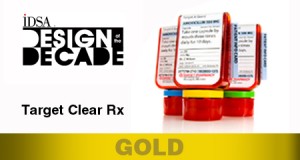 Target, fondly known as “Tar-zhay“ in my home, won the Design of the Decade award from the Industrial Designers Society of America for the innovation called ClearRx — a pill bottle. While a pill bottle might seem to be a commoditized sort of item, this bottle was designed to prevent medication mistakes committed by patients who take maintenance medications for chronic conditions.
Target, fondly known as “Tar-zhay“ in my home, won the Design of the Decade award from the Industrial Designers Society of America for the innovation called ClearRx — a pill bottle. While a pill bottle might seem to be a commoditized sort of item, this bottle was designed to prevent medication mistakes committed by patients who take maintenance medications for chronic conditions.
The National Coordinating Council for Medication Error Reporting and Prevention (NCCMERP) defines medication errors as preventable events that can cause or lead to inappropriate medication use or patient harm while the medication is in hands of patients or providers. The Institute of Medicine estimated that there are some 100,000 such events each year in their landmark report, To Err is Human.
ClearRx won the Gold award under the category of “solution to a consumer problem.” That solution includes clear labeling, large font size, an easy-to-use dispenser, and a label magnifier for those people who have aging eyes.
To see other designs that captured awards from IDSA, visit the Design of the Decade gallery here, where you’ll find many health products including the Defibtech external defibrillator, the Imogen One oxygen unit, and the LifePort kidney transporter, among other innovative designs within and outside of health.
 Health Populi’s Hot Points: “It all started with a clear dose of common sense,” explains the Clear Rx website on the Target shopping portal. Indeed. Target considers design part of its corporate DNA.
Health Populi’s Hot Points: “It all started with a clear dose of common sense,” explains the Clear Rx website on the Target shopping portal. Indeed. Target considers design part of its corporate DNA.
Design must become part of all health stakeholders’ DNA. Health plans that publish policy handbooks with arcane, difficult-to-understand language, and no online service are poorly designed for today’s plan members. Hospitals with poor signage, rooms that look and smell institutional, and bills that are impossible to understand for the average MBA let alone Joe and Jane Sixpack don’t think about the role of design. Pharmaceutical companies that might manufacture the most effective drug in a category for chronic conditions but don’t surround that medication with creative, engaging adherence programs and mobile applications (where appropriate) don’t have design in their corporate genes. Health IT developers have long lacked the design gene in their products, making usability a moot point even when the code in the background might be brilliant.
Design is a success factor for products and services in health if we expect patients to become engaged health citizens. There are many reasons why “patients are the most under-utilized resource in the health system,” as Dr. Charles Safran has been known to say. Bad design — or no design — is a major barrier to people moving toward full-on health engagement.




 Interviewed live on BNN Bloomberg (Canada) on the market for GLP-1 drugs for weight loss and their impact on both the health care system and consumer goods and services -- notably, food, nutrition, retail health, gyms, and other sectors.
Interviewed live on BNN Bloomberg (Canada) on the market for GLP-1 drugs for weight loss and their impact on both the health care system and consumer goods and services -- notably, food, nutrition, retail health, gyms, and other sectors. Thank you, Feedspot, for
Thank you, Feedspot, for  As you may know, I have been splitting work- and living-time between the U.S. and the E.U., most recently living in and working from Brussels. In the month of September 2024, I'll be splitting time between London and other parts of the U.K., and Italy where I'll be working with clients on consumer health, self-care and home care focused on food-as-medicine, digital health, business and scenario planning for the future...
As you may know, I have been splitting work- and living-time between the U.S. and the E.U., most recently living in and working from Brussels. In the month of September 2024, I'll be splitting time between London and other parts of the U.K., and Italy where I'll be working with clients on consumer health, self-care and home care focused on food-as-medicine, digital health, business and scenario planning for the future...